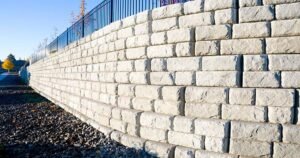Erosion can be a sneaky thief, gradually wearing away your property and diminishing its value. With rain, wind, and gravity working against you, it’s crucial to take proactive measures. That’s where retaining wall installers in West Seneca NY come into play. These skilled professionals not only enhance the aesthetic appeal of your landscape but also serve as powerful guardians against soil erosion.
If you’re looking to protect your yard from nature’s relentless forces while adding functional beauty to your outdoor space, it’s time to explore how retaining walls can make all the difference.
Let’s dive into understanding erosion and see why investing in retaining walls is a smart choice for homeowners like you!
Understanding Erosion and its Effects on Properties
Erosion is the process by which soil and rock are worn away, often leading to significant changes in your landscape. It can occur gradually or suddenly, depending on environmental factors like rain and wind.
For properties with sloped land, erosion poses a particularly serious threat. Water runoff can wash away topsoil, leaving behind barren patches that affect plant growth.
The effects of erosion extend beyond aesthetics; they can compromise the foundation of your home. As soil erodes from around your property, it may lead to structural issues over time.
Additionally, loss of soil fertility impacts gardens and lawns. Without adequate nutrients in the ground, maintaining vibrant greenery becomes a challenge.
Understanding these risks empowers homeowners to take preventive measures before it’s too late. Erosion doesn’t just impact landscapes; it affects the overall value and safety of your property as well.
Importance of Retaining Walls in Preventing Erosion
Retaining walls play a crucial role in managing soil and preventing erosion. They act as barriers that hold back soil, especially on sloped landscapes. This is essential for maintaining the integrity of your property.
When heavy rainfall occurs, water can wash away unprotected soil. Retaining walls help divert this water flow, reducing its impact on vulnerable areas. This not only keeps your yard intact but also protects nearby structures.
Additionally, these walls stabilize the ground by providing support to loose soils. By minimizing landslides and sediment runoff, retaining walls enhance overall landscape health.
Investing in quality retaining wall installation ensures long-lasting protection against erosion while adding aesthetic value to your property. Working with experienced retaining wall contractors guarantees you choose the right materials and designs tailored to your needs.
Factors to Consider Before Installing a Retaining Wall
Before diving into retaining wall installation, several key factors should be considered.
- First, assess your property’s topography. The slope and elevation play a crucial role in the design and height of the wall needed to manage soil effectively.
- Next, evaluate local regulations or zoning laws. Some areas have specific guidelines regarding construction materials and heights that must be adhered to.
- Soil type is another important consideration. Different soils react differently under pressure; knowing whether you’re dealing with clay, sand, or loam will influence your choice of materials.
- Additionally, think about drainage solutions. Proper water management is vital for preventing erosion behind the wall and ensuring its longevity.
- Consider aesthetic aspects such as color and texture that complement your landscape design. Balancing functionality with visual appeal can enhance both protection against erosion and property value.
Types of Retaining Walls and Their Benefits
Retaining walls come in various types, each with unique benefits tailored to different landscaping needs.
Gravity walls rely on their weight to resist earth pressure. They are often constructed from concrete or stone and provide a robust solution for significant elevation changes.
Cantilevered walls use leverage. Made of reinforced concrete, they’re designed for taller heights while using less material than gravity walls.
Segmental retaining walls consist of interlocking blocks. These versatile options allow for creative designs while facilitating drainage, making them popular among homeowners.
There are anchored retaining walls that incorporate cables into the soil behind the wall for added stability. This type is particularly effective in areas with high load demands or unstable soils.
Choosing the right type ensures not only aesthetic appeal but also long-lasting protection against erosion and land degradation.
Process of Hiring a Professional Retaining Wall Installer
Finding the right retaining wall installer in West Seneca NY can feel overwhelming.
- Start by researching local wall contractors who specialize in retaining walls construction.
- Check their online reviews and portfolios to gauge their experience. A reputable contractor will have a track record of successful projects that demonstrate their skill and creativity.
- Once you’ve narrowed down your options, schedule consultations. This is your chance to discuss your specific needs, vision, and budget. Ask questions about materials they recommend and their installation process.
- Get multiple quotes to compare pricing and services offered. Remember, the cheapest option isn’t always the best; quality should be a priority.
- Ensure they are licensed and insured before making any commitments. This protects you from potential liabilities during the project’s execution.
Maintenance Tips for Your Retaining Wall
Regular inspections are key to maintaining the integrity of your retaining wall. Look for cracks, bulging, or any signs of movement in the structure. These could indicate underlying issues that need immediate attention.
Proper drainage is crucial. Ensure that water flows away from your wall and that drainage systems like weep holes remain clear. This helps prevent hydrostatic pressure which can cause damage over time.
Landscaping around the wall also plays a role in its maintenance. Avoid planting large trees or shrubs too close, as their roots can compromise the stability of your structure.
Occasionally clean the surface to remove dirt and debris. A simple wash with a hose can keep it looking great while allowing you to spot potential problems early on.
Consider seasonal adjustments; check after heavy rains or snowmelt when soil erosion might be more pronounced. Taking these steps will prolong your retaining wall’s lifespan significantly.
Conclusion
Choosing the right type of retaining wall is vital too; from wooden barriers to stone structures or concrete blocks, each option offers unique benefits suited for different environments. The experience of professional wall contractors will guide you through these choices seamlessly.
Hiring professional retaining wall contractors like Soil and Seed Landscaping brings peace of mind. With their skills, they handle everything from excavation to drainage systems ensuring that every aspect meets high-quality standards while adhering to safety protocols.
Maintenance plays a key role in prolonging the life of your retaining walls. Regular inspections can help identify potential issues early on—keeping erosion at bay effectively over time.
Investing in proper erosion prevention strategies pays off significantly in maintaining your property’s value and appearance long-term. Whether you’re interested in enhancing curb appeal or protecting against rain-induced soil movement, working with skilled professionals like Soil and Seed Landscaping ensures that you make informed decisions leading towards a more secure future for your home.




